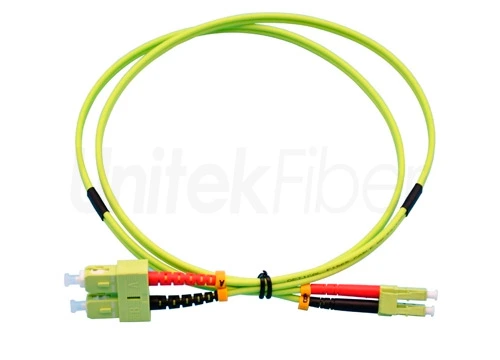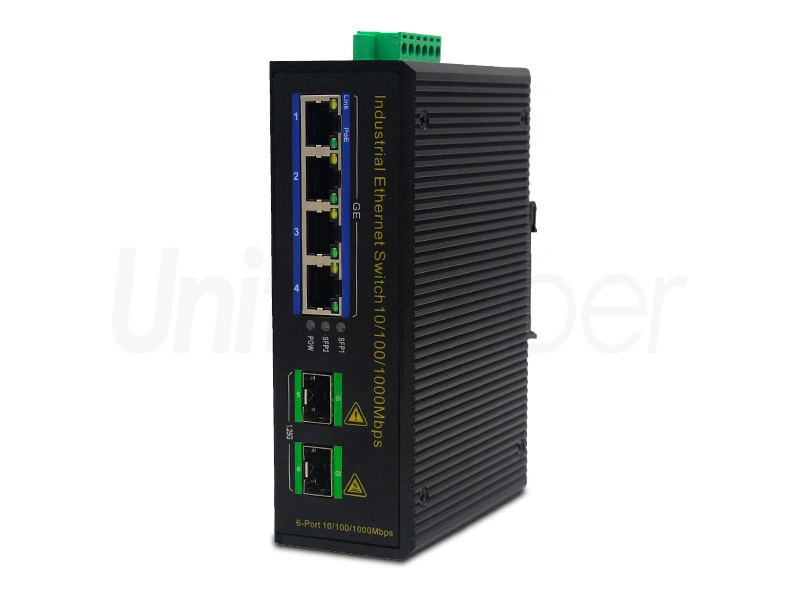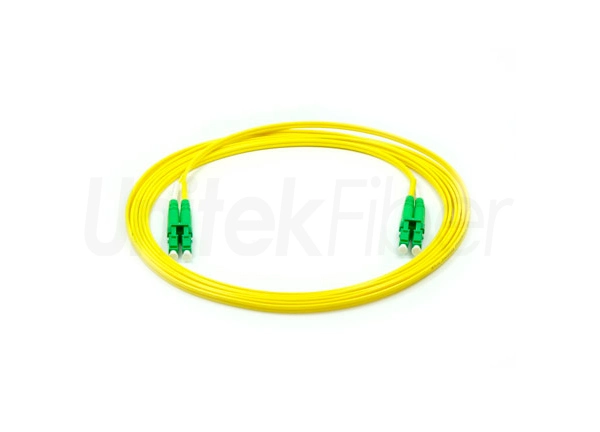

The emergence of CWDM (coarse wavelength divisio
n multiplexing) technology allows operators to find a low-cost, high-performance transmission solution. Because of its low cost, low power consumption, small size, and other advantages, CWDM has been widely used in metro transport networks. Many domestic and foreign manufacturers have also begun to develop and launch products, and ITU is also accelerating its standardization process. CWDM technology improves fiber utilization and gives operators and users greater flexibility. This article will discuss the key technologies such as CWDM characteristics, wavelength selection, and fiber type, and make a detailed comparison between CWDM and DWDM. Finally, the application and development of CWDM are prospected.
Advantages of CWDM system metro transport networks
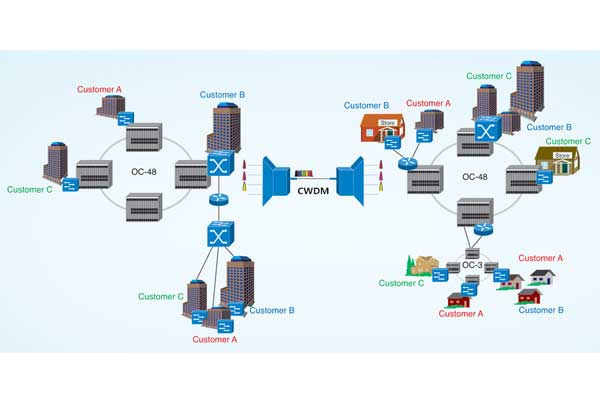
The biggest advantage of the CWDM system is its low cost, which is mainly manifested in several aspects of device, power consumption, and integration.
CWDM technology will greatly reduce the cost of construction and operation and maintenance, especially the cost of lasers and multiplexers/demultiplexers. For DWDM systems with awavelength interval of less than 50GHz, the laser needs to use a precise temperature control circuit to control the wavelength. And sometimes a wavelength locker is required to ensure the accuracy and stability of the wavelength. An optical multiplexer (filter type) requires hundreds of layers of multi-layer dielectric film devices. To prevent crosstalk between the same frequency and different frequencies, multiple filtering must be used. CWDM does not require complex technologies such as laser cooling, wavelength locking and precise coating, which greatly reduces equipment costs.
The DWDM system laser integrates a Peltier cooler. The temperature detection and control circuit uses a large amount of power and consumes about 4W per wavelength. The CWDM non-refrigerated laser and its control circuit only require about 0.5W per wavelength. For multi-wavelength and high-speed DWDM systems, single-disk power consumption control is a difficult problem in system design. The low power consumption of the CWDM system using a non-refrigerated laser reduces power backup batteries and reduces costs.
The physical size of CWDM laser is much smaller than that of DFB laser. The size of DWDM optical transmitter is about 5 times that of CWDM optical transmitter. Due to the CWDM laser structure and simple control circuit, a single module can realize multi-channel optical transceiver. At present, commercial devices have achieved 4-channel transceiver integrated into a module with a size of only 16cm´9cm´1.65cm, which is equivalent to a DWDM system optical forwarding Size. The CWDM system does not use optical amplifiers, so it may be designed as a compact desktop or box-type device, which is very convenient for installation and maintenance.
The technology ofCWDM
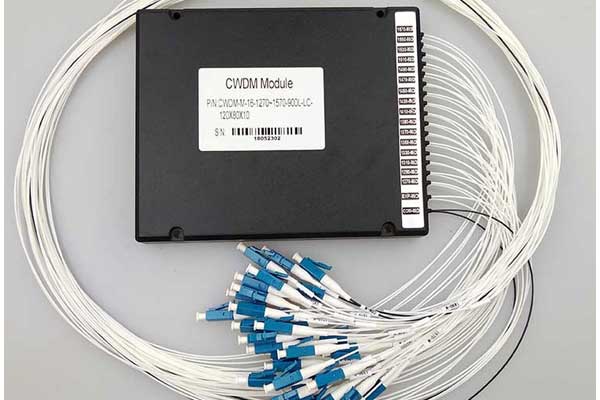
G.694.2 defines 18 nominal wavelengths of CWDM from 1270nm to 1610nm, and the wavelength interval is 20nm. This interval allows the simultaneous transmission of various wavelengths under the condition of using a non-refrigerated light source. The CWDM wavelength covers the O, E, S, C, L and other five bands of the single-mode fiber system.
The operating temperature (tube temperature) of non-refrigerating lasers usually ranges from 0°C to 70°C, and its thermal drift coefficient is about 0.08nm/°C. The nominal center wavelength value refers to the output wavelength of the laser at normal temperature, that is, 23°C. The filtering characteristics of passive devices (such as multiplexers) hardly change with temperature. It is generally believed that the nominal center wavelength of passive devices should be aligned with the output signal wavelength of the laser at 35°C, because 35°C is in the middle of the entire operating temperature range. In other words, the nominal center wavelength of the passive device should be l0 plus the wavelength drift value of the laser output from 23°C to 35°C, that is, l0 + 0.08nm/°C *(35°C -23°C) = l0+1nm. In order to solve the problem of wavelength difference caused by the difference between the nominal temperature of the laser wavelength and the actual operating temperature. The ITU shifts the G.694.2 wavelength up by 1 nm (1271 nm/1291 nm/.../1611 nm), so that the laser wavelength will just work at (1270 nm/1290 nm/.../1610 nm) in the actual environment.
In actual application, CWDM products mainly have two forms, 8-wavelength system and 16-wavelength system. The 8-wavelength system is a system with many applications. In theory,any one of the 18 wavelength choices given by ITU can be used as the operating wavelength. However, considering the type and loss characteristics of the optical fiber that has been laid, the 8 wavelength is generally selected at (1460-1620) nm, that is, the S+C+L band, avoiding the fiber water peak E band and the O band with greater loss. Additional requirements are required for optical fibers. The 16-wavelength system will impose requirements on the type of fiber, that is, a "full-wave" fiber with a flat loss must be used, and currently such fiber is rarely used. CWDM is mainly used in the access area lacking in optical fiber, and the capacity of 8 waves can mostly meet the system requirements.
Wavelength interval of CWDM
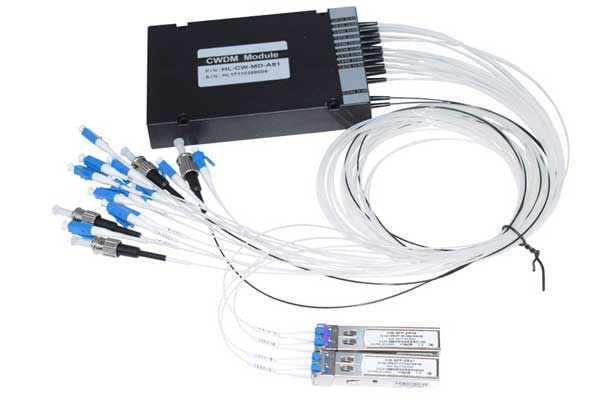
According to the current laser manufacturing technology, the wavelength change of the non-refrigerating laser should be within +/- 6~7nm under working conditions and throughout its lifetime. Taking into account sufficient adjacent channel isolation and a certain guard band (generally the minimum channel spacing is about one-third), G.694.2 selects 20nm as the channel spacing of the CWDM system. In the CWDM system, the output wavelength of the uncooled laser at 0°C~70°C changes by about 6nm, plus the wavelength deviation of the laser manufacturing process is about±3nm, and the total wavelength change will not exceed±6nm. The passband of the optical filter and the wavelength spacing between adjacent channels must be wide enough to meet the requirement of no wavelength shift of the cooling laser.
The channel spacing of the CWDM system is usually 20 NM, and the filter passband width is about 13 NM. The laser center wavelength shift must be considered consistent with the filter passband width, and the laser output wavelength must be within the filter passband range.
The Fiber glass selection for CWDM system
Most of the fiber optic cable laid in the metro area are conventional G.652 optical fiber, that is, optical fibers with a water peak at 1385nm. It cannot work normally if the loss at the 1385nm window is about 1dB. This fiber is able to open CWDM 8-wave system, working in the wavelength range (1460 ~ 1625) nm, but could not open 16-wave CWDM system. The new G.652C "full wave" fiber with flat loss can be used to open the 16-wavelength CWDM system.
Because G.655A fiber has a cut-off wavelength around 1430nm (LEAF fiber has a cut-off wavelength of 1470nm, it cannot work at 1460nm at all.) 8-wave systems have difficulties. G.655B fiber has a lower cut-off wavelength and can open an 8-wave system. Therefore, G.655 fiber can open up to 8-wave CWDM systems. Considering various factors such as cost, opening system speed, transmission distance, etc., most G.652 optical fibers are laid in the metropolitan area network. Therefore, all 8-wave CWDM systems can be opened normally. For the use of full-band full-wave G.652C fiber, you can open a 16-wave CWDM system.
The application code of CWDM has not yet been completely determined, and most of them are single-fiber unidirectional 4-wavelength or 8-wavelength systems on the market. Some manufacturers have proposed unidirectional 12-wavelength systems, and some even advocate bidirectional 6+6 and bidirectional 4+4 wavelength application methods, and use single-fiber bidirectional methods to solve bidirectional transmission problems. Considering the short length of the metropolitan area network fiber, neither dispersion nor loss will be a system-restricted factor, and the same application code should be used for G.652 and G.655 fibers.
Conclusion
CWDM technology solves the two problems of fiber shortage and multi-service transparent transmission. Low cost is its biggest advantage. The CWDM technology is mainly applied at the convergence or access level of the metropolitan area network, and has a relatively great attraction for operators in competitive areas. At present, CWDM has some applications in the domestic market, but its stability and performance still need to be observed. In addition, the price of the DWDM system has fallen rapidly, which also challenges the prospects of CWDM.

